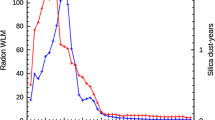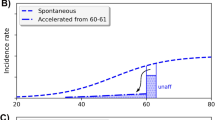Abstract
Lung cancer mortality in the period of 1948–2002 has been analysed for 6,293 male workers of the Mayak Production Association, for whose information on smoking, annual external doses and annual lung doses due to plutonium exposures was available. Individual likelihoods were maximized for the two-stage clonal expansion (TSCE) model of carcinogenesis and for an empirical risk model. Possible detrimental and protective bystander effects on mutation and malignant transformation rates were taken into account in the TSCE model. Criteria for non-nested models were used to evaluate the quality of fit. Data were found to be incompatible with the model including a detrimental bystander effect. The model with a protective bystander effect did not improve the quality of fit over models without a bystander effect. The preferred TSCE model was sub-multiplicative in the risks due to smoking and internal radiation, and more than additive. Smoking contributed 57% to the lung cancer deaths, the interaction of smoking and radiation 27%, radiation 10%, and others cause 6%. An assessment of the relative biological effectiveness of plutonium was consistent with the ICRP recommended value of 20. At age 60 years, the excess relative risk (ERR) per lung dose was 0.20 (95% CI: 0.13; 0.40) Sv−1, while the excess absolute risk (EAR) per lung dose was 3.2 (2.0; 6.2) per 104 PY Sv. With increasing age attained the ERR decreased and the EAR increased. In contrast to the atomic bomb survivors, a significant elevated lung cancer risk was also found for age attained younger than 55 years. For cumulative lung doses below 5 Sv, the excess risk depended linearly on dose. The excess relative risk was significantly lower in the TSCE model for ages attained younger than 55 than that in the empirical model. This reflects a model uncertainty in the results, which is not expressed by the standard statistical uncertainty bands.






Similar content being viewed by others
Notes
Hirosoft International Corporation, Seattle, WA, USA.
For the rescaling it is assumed that 1 working level month corresponds to 0.005 Sv effective dose or 0.04 Sv lung dose.
References
Brenner DJ, Doll R, Goodhead DT, Hall EJ, Land CE, Little JB, Lubin JH, Preston DL, Preston RJ, Puskin JS, Ron E, Sachs RK, Samet JM, Setlow RB, Zaider M (2003) Cancer risk attributable to low doses of ionizing radiation: assessing what we really know. Proc Natl Acad Sci 100:13761–13766
Sachs RK, Chan M, Hlatky L, Hahnfeldt P (2005) Modeling intercellular interactions during carcinogenesis. Radiat Res 164:324–331
Moolgavkar SH, Venzon DJ (1979) Two-events models for carcinogenesis: incidence curves for childhood and adult tumors. Math Biosci 47:55–77
Moolgavkar S, Knudson A (1981) Mutation and cancer: a model for human carcinogenesis. J Natl Cancer Inst 66:1037–1052
Jacob V, Jacob P (2004) Modelling of carcinogenesis and low-dose hypersensitivity: an application to lung cancer incidence among atomic bomb survivors. Radiat Environ Biophys 42:265–273
Coates PJ, Lorimore SA, Wright EG (2004) Damaging and protective cell signalling in the untargeted effects of ionizing radiation. Mutat Res 568:5–20
Nagasawa H, Little B (1999) Unexpected sensitivity to the induction of mutations by very low doses of alpha particle radiation: evidence for a bystander effect. Radiat Res 54:552–557
Zhou HG, Randers-Pehrson G, Waldren CA, Vannais D, Hall EJ, Hei TK (2000) Induction of a bystander mutagenic effect of alpha particles in mamalian cells. Proc Natl Acad Sci 97:2099–2104
Koshurnikova NA, Bolotnikova MG, Ilyin LA, Keirim-Markus IB, Menshikh ZS, Okatenko PV, Romanov SA, Tcvetkov VI, Shilnikova NS (1998) Lung cancer risk due to exposure to incorporated plutonium. Radiat Res 149:366–371
Kreisheimer M, Sokolnikov ME, Koshurnikova NA, Khokhryakov VF, Romanow SA, Shilnikova NS, Okatenko PV, Nekolla EA, Kellerer AM (2003) Lung cancer mortality among nuclear workers of the Mayak facilities in the former Soviet Union. Radiat Environ Biophys 42:129–135
Gilbert ES, Koshurnikova NA, Sokolnikov ME, Shilnikova NS, Preston DL, Ron E, Okatenko PV, Khokhryakov VF, Vasilenko EK, Miller S, Eckerman K, Romanov SA (2004) Lung cancer in Mayak workers. Radiat Res 162:505–515
Jacob V, Jacob P, Meckbach R, Romanov SA, Vasilenko EK (2005) Lung cancer in Mayak workers: interaction of smoking and plutonium exposure. Radiat Environ Biophys 44:119–129
Jacob V, Jacob P, Meckbach R, Romanov SA, Vasilenko EK (2006) Lung cancer in Mayak workers: interaction of smoking and plutonium exposure. Radiat Environ Biophys 44:307 (Erratum)
Walsh L (2007) A short review of model selection techniques for radiation epidemiology. Radiat Environ Biophys. doi:10.1007/s00411–007–0109–0
ICRP Publication 66 (1994) Human respiratory tract model for radiological protection. Ann ICRP 24(1–3):1–482
Khokhryakov VF, Suslova KG, Vostrotin VV, Romanov SA, Eckerman KF, Krahenbuhl MP, Miller SC (2005) Adaptation of the ICRP publication 66 respiratory tract model to data on plutonium biokinetics for Mayak workers. Health Phys 2:125–132
ICRP Publication 67 (1994) Age-dependent doses to members of the public from intake of radionuclides: Part 2. Ingestion dose coefficients. Ann ICRP 23(3–4):1–167
Leggett RW, Eckerman KF, Khokhryakov VF, Suslova KG, Krahenbuhl MP, Miller SC (2005) Mayak worker study: an improved biokinetic model for reconstructing doses from internally deposited plutonium. Radiat Res 164:111–122
Heidenreich WF, Jacob P, Paretzke HG (1997) Exact solutions of the clonal expansion model and their application to the incidence of solid tumors of atomic bomb survivors. Radiat Environ Biophys 36:45–58
Akaike H (1973) Information theory and an extension of the maximum likelihood principle. In: Petrov and BN, Caski F (eds) Proceedings of the 2nd international symposium on information theory. Budapest, Hungary, Akademiai Kiado, pp 267–281
Schwarz G (1978) Estimating the dimension of a model. Ann Stat 6:461–464
Luebeck AG, Heidenreich WF, Hazelton WD, Paretzke HG, Moolgavkar SH (1999) Biologically based analysis of the data for the Colorado uranium miners cohort: age, dose and dose-rate effects. Radiat Res 152:339–351
Jacob P, Walsh L, Eidemüller M (2007) Modelling of carcinogenesis and cell killing in the atomic bomb survivors with applications to the mortality from all solid, stomach and liver cancers. (submitted)
ICRP Publication 60 (1992) 1990 Recommendations of the international commission on radiological protection. Ann ICRP 21(1–3):1–201
Jacob P, Jacob V (2003) Biological parameters for lung cancer in mathematical models of carcinogenesis. Radiat Prot Dosim 104:357–366
Wistuba II, Behrens C, Virmani AK, Mele G, Milchgrub S, Girard L, Fondon JW, Garner HR, McKay B, Latif F, Lerman MI, Lam S, Gazdar AF, Minna JD (2000) High resolution chromosome 3p allelotyping of human lung cancer and preneoplastic/preinvasive bronchial epithelium reveals multiple, discontinuous sites of 3p allele loss and three regions of frequent breakpoints. Cancer Res 60:1949–1960
Kopp-Schneider A, Haertel T, Burkolder I, Bannasch P, Wesch H, Groos J, Heeger S (2006) Investigating the formation and growth of α-particle radiation-induced foci of altered hepatocytes: a model-based approach. Radiat Res 166:422–430
Sokolnikov ME, Khokhryakov VF, Vasilenko EK, Koshournikova NA (2003) Risk of lung cancer development in the personnel exposed to internal radiation as a result of incorporated Pu. Sibirian Med J 5:31–35 (in Russian)
Darby S, Hill D, Auvinen A, Barros-Dios JM, Baysson H, Bochicchio F, Deo H, Falk R, Forastiere F, Hakama M, Heid I, Kreienbrock L, Kreuzer M, Lagarde FC, Mäkeläinen I, Muirhead C, Oberaigner W, Pershagen G, Ruano-Ravina A, Ruosteenoja E, Schaffrath RA, Tirmarche MA, Tomášek L, Whitley E, Wichmann HE (2005) Radon in homes and risk of lung cancer: collaborative analysis of individual data from 13 European case-control studies. BMJ 330:223–226
Preston DL, Shimizu Y, Pierce DA, Suyama A, Mabuchi K (2003) Studies of mortality of atomic bomb survivors. Report 13: Solid cancer and non-cancer disease mortality: 1950–1997. Radiat Res 160:381–407
Acknowledgments
The authors thank Nina Koshurnikova for stimulating discussions. The work has been supported by the German Federal Ministry of Environment, Nature Preservation and Reactor Safety, and the German Federal Office of Radiation Protection under contract number StSch 4479.
Author information
Authors and Affiliations
Corresponding author
Appendix
Appendix
The definition of γ j in Eq. 1 and β j > 0 imply
With μ j > 0 it follows that
Further, the definition of q j in Eq. 1 implies
Insertion in Eq. 12 yields
or
So, if γ j > 0, then
Rights and permissions
About this article
Cite this article
Jacob, P., Meckbach, R., Sokolnikov, M. et al. Lung cancer risk of Mayak workers: modelling of carcinogenesis and bystander effect. Radiat Environ Biophys 46, 383–394 (2007). https://doi.org/10.1007/s00411-007-0117-0
Received:
Accepted:
Published:
Issue Date:
DOI: https://doi.org/10.1007/s00411-007-0117-0




